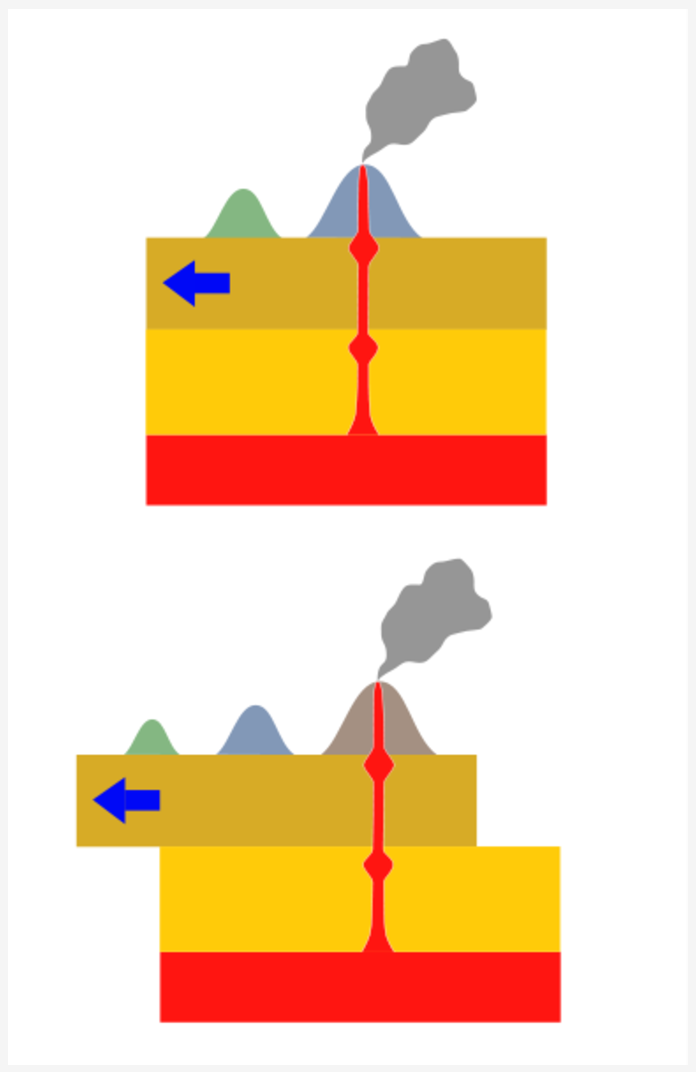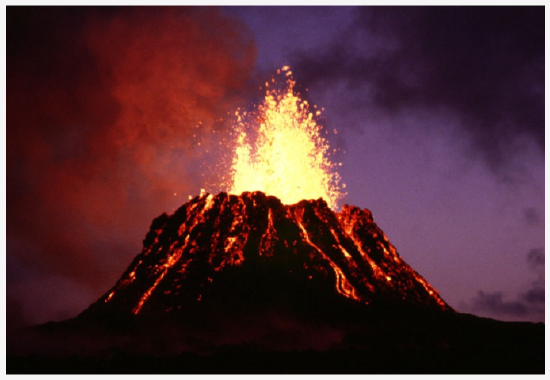5.16: Hot Spots
- Page ID
- 2532
\( \newcommand{\vecs}[1]{\overset { \scriptstyle \rightharpoonup} {\mathbf{#1}} } \)
\( \newcommand{\vecd}[1]{\overset{-\!-\!\rightharpoonup}{\vphantom{a}\smash {#1}}} \)
\( \newcommand{\dsum}{\displaystyle\sum\limits} \)
\( \newcommand{\dint}{\displaystyle\int\limits} \)
\( \newcommand{\dlim}{\displaystyle\lim\limits} \)
\( \newcommand{\id}{\mathrm{id}}\) \( \newcommand{\Span}{\mathrm{span}}\)
( \newcommand{\kernel}{\mathrm{null}\,}\) \( \newcommand{\range}{\mathrm{range}\,}\)
\( \newcommand{\RealPart}{\mathrm{Re}}\) \( \newcommand{\ImaginaryPart}{\mathrm{Im}}\)
\( \newcommand{\Argument}{\mathrm{Arg}}\) \( \newcommand{\norm}[1]{\| #1 \|}\)
\( \newcommand{\inner}[2]{\langle #1, #2 \rangle}\)
\( \newcommand{\Span}{\mathrm{span}}\)
\( \newcommand{\id}{\mathrm{id}}\)
\( \newcommand{\Span}{\mathrm{span}}\)
\( \newcommand{\kernel}{\mathrm{null}\,}\)
\( \newcommand{\range}{\mathrm{range}\,}\)
\( \newcommand{\RealPart}{\mathrm{Re}}\)
\( \newcommand{\ImaginaryPart}{\mathrm{Im}}\)
\( \newcommand{\Argument}{\mathrm{Arg}}\)
\( \newcommand{\norm}[1]{\| #1 \|}\)
\( \newcommand{\inner}[2]{\langle #1, #2 \rangle}\)
\( \newcommand{\Span}{\mathrm{span}}\) \( \newcommand{\AA}{\unicode[.8,0]{x212B}}\)
\( \newcommand{\vectorA}[1]{\vec{#1}} % arrow\)
\( \newcommand{\vectorAt}[1]{\vec{\text{#1}}} % arrow\)
\( \newcommand{\vectorB}[1]{\overset { \scriptstyle \rightharpoonup} {\mathbf{#1}} } \)
\( \newcommand{\vectorC}[1]{\textbf{#1}} \)
\( \newcommand{\vectorD}[1]{\overrightarrow{#1}} \)
\( \newcommand{\vectorDt}[1]{\overrightarrow{\text{#1}}} \)
\( \newcommand{\vectE}[1]{\overset{-\!-\!\rightharpoonup}{\vphantom{a}\smash{\mathbf {#1}}}} \)
\( \newcommand{\vecs}[1]{\overset { \scriptstyle \rightharpoonup} {\mathbf{#1}} } \)
\( \newcommand{\vecd}[1]{\overset{-\!-\!\rightharpoonup}{\vphantom{a}\smash {#1}}} \)
\(\newcommand{\avec}{\mathbf a}\) \(\newcommand{\bvec}{\mathbf b}\) \(\newcommand{\cvec}{\mathbf c}\) \(\newcommand{\dvec}{\mathbf d}\) \(\newcommand{\dtil}{\widetilde{\mathbf d}}\) \(\newcommand{\evec}{\mathbf e}\) \(\newcommand{\fvec}{\mathbf f}\) \(\newcommand{\nvec}{\mathbf n}\) \(\newcommand{\pvec}{\mathbf p}\) \(\newcommand{\qvec}{\mathbf q}\) \(\newcommand{\svec}{\mathbf s}\) \(\newcommand{\tvec}{\mathbf t}\) \(\newcommand{\uvec}{\mathbf u}\) \(\newcommand{\vvec}{\mathbf v}\) \(\newcommand{\wvec}{\mathbf w}\) \(\newcommand{\xvec}{\mathbf x}\) \(\newcommand{\yvec}{\mathbf y}\) \(\newcommand{\zvec}{\mathbf z}\) \(\newcommand{\rvec}{\mathbf r}\) \(\newcommand{\mvec}{\mathbf m}\) \(\newcommand{\zerovec}{\mathbf 0}\) \(\newcommand{\onevec}{\mathbf 1}\) \(\newcommand{\real}{\mathbb R}\) \(\newcommand{\twovec}[2]{\left[\begin{array}{r}#1 \\ #2 \end{array}\right]}\) \(\newcommand{\ctwovec}[2]{\left[\begin{array}{c}#1 \\ #2 \end{array}\right]}\) \(\newcommand{\threevec}[3]{\left[\begin{array}{r}#1 \\ #2 \\ #3 \end{array}\right]}\) \(\newcommand{\cthreevec}[3]{\left[\begin{array}{c}#1 \\ #2 \\ #3 \end{array}\right]}\) \(\newcommand{\fourvec}[4]{\left[\begin{array}{r}#1 \\ #2 \\ #3 \\ #4 \end{array}\right]}\) \(\newcommand{\cfourvec}[4]{\left[\begin{array}{c}#1 \\ #2 \\ #3 \\ #4 \end{array}\right]}\) \(\newcommand{\fivevec}[5]{\left[\begin{array}{r}#1 \\ #2 \\ #3 \\ #4 \\ #5 \\ \end{array}\right]}\) \(\newcommand{\cfivevec}[5]{\left[\begin{array}{c}#1 \\ #2 \\ #3 \\ #4 \\ #5 \\ \end{array}\right]}\) \(\newcommand{\mattwo}[4]{\left[\begin{array}{rr}#1 \amp #2 \\ #3 \amp #4 \\ \end{array}\right]}\) \(\newcommand{\laspan}[1]{\text{Span}\{#1\}}\) \(\newcommand{\bcal}{\cal B}\) \(\newcommand{\ccal}{\cal C}\) \(\newcommand{\scal}{\cal S}\) \(\newcommand{\wcal}{\cal W}\) \(\newcommand{\ecal}{\cal E}\) \(\newcommand{\coords}[2]{\left\{#1\right\}_{#2}}\) \(\newcommand{\gray}[1]{\color{gray}{#1}}\) \(\newcommand{\lgray}[1]{\color{lightgray}{#1}}\) \(\newcommand{\rank}{\operatorname{rank}}\) \(\newcommand{\row}{\text{Row}}\) \(\newcommand{\col}{\text{Col}}\) \(\renewcommand{\row}{\text{Row}}\) \(\newcommand{\nul}{\text{Nul}}\) \(\newcommand{\var}{\text{Var}}\) \(\newcommand{\corr}{\text{corr}}\) \(\newcommand{\len}[1]{\left|#1\right|}\) \(\newcommand{\bbar}{\overline{\bvec}}\) \(\newcommand{\bhat}{\widehat{\bvec}}\) \(\newcommand{\bperp}{\bvec^\perp}\) \(\newcommand{\xhat}{\widehat{\xvec}}\) \(\newcommand{\vhat}{\widehat{\vvec}}\) \(\newcommand{\uhat}{\widehat{\uvec}}\) \(\newcommand{\what}{\widehat{\wvec}}\) \(\newcommand{\Sighat}{\widehat{\Sigma}}\) \(\newcommand{\lt}{<}\) \(\newcommand{\gt}{>}\) \(\newcommand{\amp}{&}\) \(\definecolor{fillinmathshade}{gray}{0.9}\)In geology, the places known as hotspots or hot spots are volcanic regions thought to be fed by underlying mantle that is anomalously hot compared with the surrounding mantle. They may be on, near to, or far from tectonic plate boundaries. Currently, there are two hypotheses that attempt to explain their origins. One suggests that they are due to hot mantle plumes that rise as thermal diapirs from the core-mantle boundary. An alternative hypothesis postulates that it is not high temperature that causes the volcanism, but lithospheric extension that permits the passive rising of melt from shallow depths. This hypothesis considers the term “hotspot” to be a misnomer, asserting that the mantle source beneath them is, in fact, not anomalously hot at all. Well known examples include Hawaii and Yellowstone.

BACKGROUND
The origins of the concept of hotspots lie in the work of J. Tuzo Wilson, who postulated in 1963 that the Hawaiian Islands result from the slow movement of a tectonic plate across a hot region beneath the surface. It was later postulated that hotspots are fed by narrow streams of hot mantle rising from the Earth’score-mantle boundary in a structure called amantle plume. Whether or not such mantle plumes exist is currently the subject of a major controversy in Earth science. Estimates for the number of hotspots postulated to be fed by mantle plumes has ranged from about 20 to several thousands, over the years, with most geologists considering a few tens to exist. Hawaii, Réunion, Yellowstone, Galápagos, and Iceland are some of the currently most active volcanic regions to which the hypothesis is applied.
Most hotspot volcanoes are basaltic (e.g., Hawaii, Tahiti). As a result, they are less explosive than subduction zone volcanoes, in which water is trapped under the overriding plate. Where hotspots occur in continental regions, basaltic magma rises through the continental crust, which melts to form rhyolites. These rhyolites can form violent eruptions. For example, the Yellowstone Caldera was formed by some of the most powerful volcanic explosions in geologic history. However, when the rhyolite is completely erupted, it may be followed by eruptions of basaltic magma rising through the same lithospheric fissures (cracks in the lithosphere). An example of this activity is the Ilgachuz Range in British Columbia, which was created by an early complex series of trachyte and rhyolite eruptions, and late extrusion of a sequence of basaltic lava flows.
The hotspot hypothesis is now closely linked to the mantle plume hypothesis.
Comparison with Island Arc Volcanoes
Hotspot volcanoes are considered to have a fundamentally different origin from island arc volcanoes. The latter form over subduction zones, at converging plate boundaries. When one oceanic plate meets another, the denser plate is forced downward into a deep ocean trench. This plate, as it is subducted, releases water into the base of the over-riding plate, and this water mixes with the rock, thus changing its composition causing some rock to melt and rise. It is this that fuels a chain of volcanoes, such as the Aleutian Islands, near Alaska.
HOTSPOT VOLCANIC CHAINS
The joint mantle plume/hotspot hypothesis envisages the feeder structures to be fixed relative to one another, with the continents and seafloor drifting overhead. The hypothesis thus predicts that time-progressive chains of volcanoes are developed on the surface. Examples are Yellowstone, which lies at the end of a chain of extinct calderas, which become progressively older to the west. Another example is the Hawaiian archipelago, where islands become progressively older and more deeply eroded to the northwest.
Geologists have tried to use hotspot volcanic chains to track the movement of the Earth’s tectonic plates. This effort has been vexed by the lack of very long chains, by the fact that many are not time-progressive (e.g. the Galápagos) and by the fact that hotspots do not appear to be fixed relative to one another (e.g., Hawaii and Iceland.)
Postulated Hotspot Volcano Chains
- Hawaiian-Emperor seamount chain (Hawaii hotspot)
- Louisville seamount chain (Louisville hotspot)
- Walvis Ridge (Gough and Tristan hotspot)
- Kodiak–Bowie Seamount chain (Bowie hotspot)
- Cobb-Eickelberg Seamount chain (Cobb hotspot)
- New England Seamount chain (New England hotspot)
- Anahim Volcanic Belt (Anahim hotspot)
- Mackenzie dike swarm (Mackenzie hotspot)
- Great Meteor hotspot track (New England hotspot)
- St. Helena Seamount Chain – Cameroon Volcanic Line (Saint Helena hotspot)
- Southern Mascarene Plateau–Chagos-Maldives-Laccadive Ridge (Réunion hotspot)
- Ninety East Ridge (Kerguelen hotspot)
- Tuamotu–Line Island chain (Easter hotspot)
- Austral–Gilbert–Marshall chain (Macdonald hotspot)
- Juan Fernández Ridge (Juan Fernández hotspot)

List of Volcanic Regions Postulated to be Hotspots
Eurasian Plate
- Eifel hotspot
- Iceland hotspot
- Azores hotspot
- Jan Mayen hotspot
- Hainan hotspot
African Plate
- Mount Etna
- Hoggar hotspot
- Tibesti hotspot
- Jebel Marra/Darfur hotspot
- Afar hotspot
- Cameroon hotspot
- Madeira hotspot
- Canary hotspot
- New England/Great Meteor hotspot
- Cape Verde hotspot
- St. Helena hotspot
- Gough hotspot
- Tristan hotspot
- Vema hotspot (Vema Seamount)
- Discovery hotspot (Discovery Seamounts)
- Bouvet hotspot
- Shona/Meteor hotspot
- Réunion hotspot
- Comoros hotspot
Antartic Plate
- Marion hotspot
- Crozet hotspot
- Kerguelen hotspot
- Heard hotspot
- Balleny hotspot
- Erebus hotspot
South American Plate
- Trindade/Martin Vaz hotspot
- Fernando hotspot
- Ascension hotspot
North American Plate
- Bermuda hotspot
- Yellowstone hotspot
- Raton hotspot
- Anahim hotspot
Indo-Australian Plate
- Lord Howe hotspot
- Tasmanid hotspot (Gascoyne Seamount)
- East Australia hotspot
Nazca Plate
- Juan Fernández hotspot
- San Felix hotspot
- Easter hotspot
- Galápagos hotspot
Pacific Plate
- Louisville hotspot
- Foundation hotspot
- Macdonald hotspot
- North Austral/President Thiers (President Thiers Bank)
- Arago hotspot (Arago Seamount)
- Maria/Southern Cook hotspot (Îles Maria)
- Samoa hotspot
- Crough hotspot (Crough Seamount)
- Pitcairn hotspot
- Society/Tahiti hotspo
- Marquesas hotspot
- Caroline hotspot
- Hawaii hotspot
- Socorro/Revillagigedos hotspot
- Guadalupe hotspot
- Cobb hotspot
- Bowie/Pratt-Welker hotspot
FORMER HOTSPOTS
- Euterpe/Musicians hotspot (Musicians Seamounts)
- Mackenzie hotspot
- Matachewan hotspot
REFLECTION QUESTIONS
- What skill does this content help you develop?
- What are the key topics covered in this content?
- How can the content in this section help you demonstrate mastery of a specific skill?
- What questions do you have about this content?
Contributors and Attributions
Original content from Kimberly Schulte (Columbia Basin College) and supplemented by Lumen Learning. The content on this page is copyrighted under a Creative Commons Attribution 4.0 International license.


